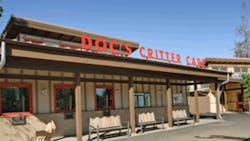SAN JOSE, CALIF. — After years of construction, planning and design, San Jose's Happy Hollow Park & Zoo, the first amusement park and zoo in the country to receive U.S. Green Building Council LEED Gold certification, reopened this March and is utilizing sustainable systems and products to reduce water usage by 50%, potable water usage by 30%, and energy costs below the projected costs per ASHRAE and the California Title 24 energy codes.
The $72 million renovation project, totaling 12,800-sq.ft., includes a four-acre expansion that houses the new Zoo on the Hill, and brand new retail, guest services, education, concessions, administration, medical and commissary buildings.
"The renovation of Happy Hollow is another example of San Jose's leadership in green buildings and architecture," said Mayor Chuck Reed. "The park's innovative green features will show how it's possible to reduce operating costs while promoting sustainability."
All buildings except the concessions building and part of the medical building utilize a two-pipe radiant floor system by Watts Radiant along with direct fire Weil McLain boilers, which were installed by the mechanical contracting firm O.C. McDonald Co., San Jose, Calif. The system provides heating during the winter and cooling during the summer. Plus, electric water heaters by A.O. Smith are being utilized to heat domestic water for all buildings on the property.
The concessions and medical buildings required a broader range of mechanical equipment given the concessions building has high occupancy and the medical building needs to meet laboratory requirements, according to Jason Evans, project manager at O.C. McDonald Co. The concessions building utilizes McQuay air handling equipment, and the medical building utilizes Innovent air handling equipment and humidifiers by Nortec, along with evaporative cooling for high occupancy spaces.
“The concessions building has a high occupant load plus internal heat generation from the kitchen,” explained Paul Sorensen, project manager, The Portico Group, the project’s lead design firm.“The medical building has surgery, neocropsy and interior quarantine of new animals. All three uses require an HVAC system that can meet the medical/lab requirements similar to laboratory buildings.”
Clerestory windows were also installed in the buildings to vent warm air from inside while providing natural light in the buildings.
“Clerestory windows provide daylighting and reduce the use of electrical light, which in turn reduces cooling loads,” explained Sorensen.“Clerestory also provides a chimney effect for venting air warmed by occupant, equipment and heat gain loads.”
There were only a few challenges when installing the project’s mechanical systems.
“The Animal Care center with limited ceiling space for installing humidifiers was a challenge,” said Evans. “And the mechanical rooms were very small, requiring careful coordination amongst the trades to allow for accessibility and clearances for maintenance.”
Water conservation
Low-flow plumbing fixtures and urinals by American Standard are being utilized to reduce potable water use by 30% along with Sloan flushometers and electronic faucets. Symmons’ shower valves, J.R. Smith fixture carriers, and Chicago faucets were also installed in the buildings along with Haws drinking fountains.
Plus, high-efficiency irrigation systems, below-ground drip lines and bubbler are reducing water usage by 50%. Happy Hollow is also utilizing the city’s reclaimed water in lieu of potable water.
According to Evans, the urinals are using reclaimed water and all waterlines for reclaimed water are wrapped with purple marking tape per code.
Other green features at the zoo and park include seven green roofs with native plant species, plus, the city of San Jose is buying green power certificates from Renewable Choice Energy, a national provider of greenhouse gas measurement services, energy efficiency solutions and renewable energy credits (RECs), for energy consumption to ensure the zoo and park utilize energy from a renewable energy facility.
"We are proud to be a green model for the nation and the zoo and aquarium industry, as well as the important role we play in our community as a sustainability leader," said Suzanne Wolf, general manager of Happy Hollow Park and Zoo.
Happy Hollow, a city-owned and operated park and zoo, occupies 13+ acres of the northwest corner of the frequently-used Kelly Park. San Jose voters funded its modernization and expansion in 2000 based upon a city-authored 1994 master plan. Visitors can take a self-guided or staff-guided tour of the green buildings and conservation efforts.
Related Articles:
Hansen Mechanical performs boiler upgrade at zoo
About the Author
Candace Roulo
Candace Roulo, senior editor of CONTRACTOR and graduate of Michigan State University’s College of Communication Arts & Sciences, has 15 years of industry experience in the media and construction industries. She covers a variety of mechanical contracting topics, from sustainable construction practices and policy issues affecting contractors to continuing education for industry professionals and the best business practices that contractors can implement to run successful businesses.
